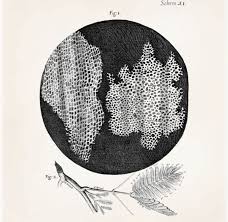The observation by Robert Hooke in 1665 of what became coined the cell provided the starting point for a sequence of discoveries at the microscopic level. A rapid pace of discoveries quickly followed and has continued into our present time. From this moment onward our view of life has been revolutionized. But while it was Hooke who observed the cell by viewing thin layers of cork, it was Antony Van Leeuwenhoek who can be considered as the first microbiologist and dramatically expended our view of cellular life.
The Discovery of the Cell

(Credit: Micrographia, 1665)
The invention of the microscope in 1608 allowed for the discovery of the cell. Microscopes had been around for about a generation or so before Hooke began making and using his own instruments. By this time microscopes were very rudimentary, but Hooke’s had a technical supremacy in that it could magnify by up to 40x to 50x making it the best of its time. In 1663 and the following year Hook began making his microscopic observations. In 1665 he published his work in a book titled Micrographia. It was the first major publication of the Royal Society.
Meanwhile in Antony Van Leeuwenhoek was living in the Dutch Republic working as a textile worker. He was not a formally trained scientist at the time and was largely a self-taught man. He came across Micrographia and was fascinated by what he read and saw in it. He was already proficient in lens making and in the 1670s he started observing microbial world. He developed terrifically powerful microscope – ones that could magnify up to 270x. To the dismay of many was highly secretive about his techniques. Over the course of Van Leeuwenhoek ‘s career he made almost 200 reports to the Royal Society – offering facts of his findings including drawings. Leeuwenhoek began his work by analyzing drops of pond water. He also went to work on replicating some of Hooke’s earlier observations. In 1676 he to some of this tooth plaque and saw there were thousands of what he called living animalcules because they were moving like little animals. He had discovered bacteria.
A Wondrous Biological Factory
Contained in the cell are the structural and functional operations of a living organism, making it the basic building block of life. All cells follow a similar basic plan. The cell membrane is the outer most layer of the cell and is composed of a mixture of lipids and proteins. Inside the cell is whats called the cytoplasm, which is a complex mixture of water, salts, enzymes, and other organic molecules or organelles. The cytoplasm includes the cell nucleus which contains the cells genetic material.
The inside of a cell is a busy place. That activity that happens there can be mind boggling. A cell is made up of millions of objects performing a multitude of tasks. Millions of chemical reactions are taking place inside each cell. Enzymes, which are a specific type of protein, perform up to a thousand tasks per second. Some proteins exist for a short of thirty minutes, others for up to weeks. Each cell contains up to 20,000 different proteins. These proteins can be made up of up to 50,000 molecules. This means each cell can be made up of hundreds of millions of chemical molecules, a staggering amount of chemical activity.
Most of the food we eat and oxygen we breath are taken to the mitochondria, where it is converted into a form of energy called ATP. A typical cell in each human body will contain about a billion ATP molecules. In a matter of minutes all of these molecules will be used up, and another billion will have replaced them. Each day every person produces about half of their weight in ATP. This weight mostly comes from the air that we breath.
From Cell Discovery to Cell Theory
The discovery of the cell lead to the elucidation of a core theory in biology called cell theory, which roughly states that all living organisms are made from basic units called cells that continually reproduce. It would take another 150 years after the discovery of the cell for cell theory to become established.
Critical work in advancing cell theory began in the early 19th century. In 1838 Matthias Jakob Schleiden was working with plants and concluded that all plants are made up as cells. This influenced the German physiologist Theodor Schwann and the next year he published Microscopical Researches into the Accordance in the Structure and Growth of Animals and Plants, a landmark work where he proposed his own Cell Theory.
Continue reading more about the exciting history of science!